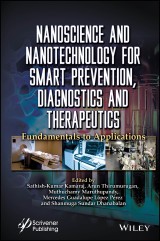Details
Nanoscience and Nanotechnology for Smart Prevention, Diagnostics and Therapeutics
Fundamentals to Applications1. Aufl.
|
173,99 € |
|
| Verlag: | Wiley |
| Format: | |
| Veröffentl.: | 11.06.2024 |
| ISBN/EAN: | 9781394175215 |
| Sprache: | englisch |
| Anzahl Seiten: | 416 |
DRM-geschütztes eBook, Sie benötigen z.B. Adobe Digital Editions und eine Adobe ID zum Lesen.
Beschreibungen
<p><b>The book presents the fundamentals of nanomaterials, discusses the direct applications of nanomaterials to the biomedical sector, and explores the potential therapeutic applications of nanotheranostics.</b> <p>This book focuses on the fundamental features of various nanomaterials that are related to the development of biomedical technologies. These fundamental qualities are broken up into three parts: prevention, diagnostics, and therapeutics. When it comes to infectious diseases, prevention is of the utmost importance. Highly advanced nanomaterials including silver, titanium, graphene-based filters, and copper nanoparticles are used to fight infectious illnesses. Once the symptoms have been recognized in the patients, through the use of effective and straightforward nanodiagnostic techniques, the diseases can be accurately localized in either a qualitative or quantitative manner. Nanodiagnostics tools currently dominate the field of biomedical diagnostics because of their high degree of accuracy, low requirement for samples and reagents, user-friendliness, portability, and capacity to perform point-of-care (POC) applications. Nanomaterials are widely used in imaging due to many factors, including: their signal generation and amplification abilities; the ongoing development of reliant new imaging techniques, such as photoacoustic imaging and Raman imaging; their targeting potential, due to the possibility of functionalizing their surface with cancer-targeting moieties; their multimodality, since some nanomaterials can generate signals for more than one imaging technique; and their affordability. Modern therapeutics explores the various nanotechnological advances to cure the site-specific cancer treatment most prominently. The book explores the fundamentals of nanomaterials and discloses their direct application to the biomedical field. Finally, the book discusses future therapeutic applications of nanotheranostics. <p><b>Audience</b> <p>The book will be read by scientists, researchers, and post-graduate students in the biomedical-related engineering field, nanoscience and nanotechnology, materials science, and bionanotechnology.
<p><b>Sathish-Kumar Kamaraj, PhD, DSc,</b> is a research professor at Bio-Nano Interface Technology for Sustainable Energy and an Environment research group leader at the Technological Institute of El llano Aguascalientes, National Technological Institute of Mexico. He obtained a Doctorate in Nanoscience and Nanotechnology in 2014. He has published more than 50 research articles in journals, several book chapters, and has been granted 3 patents. <p><b>Arun Thirumurugan, PhD,</b> is an assistant professor at the University of ATACAMA, Chile working on the development of magnetic nanocomposites for energy storage and biological applications. He obtained his PhD in 2015 in physics. His research interests are synthesizing magnetic nanoparticles, and surface modification of nanomaterials. He has published more than 80 research articles in international journals, several book chapters and contributions to conference volumes. <p><b>Muthuchamy Maruthupandy, PhD,</b> is a postdoctoral researcher in the Department of Health Sciences at Dong-A University in Busan, South Korea. He obtained his PhD in microbiology in 2016. His research interests include biopolymer-mediated nanomaterials, biosensors, nanomedicine, and bioelectronics. He has published more than 70 research articles in peer-reviewed international publications, as well as several book chapters and conference reports. <p><b>Mercedes Guadalupe López Pérez, PhD,</b> is a principal investigator at the Department of Biotechnology and Biochemistry, Center for Research and Advanced Studies of the National Polytechnic Institute, Cinvestav-Irapuato, Guanajuato, Mexico. She has published more than 120 research articles in international journals, multiple book chapters and has focused her research studies on metabolites of Mesoamerican plants with health potential. She has published more than 120 international peer-reviewed articles and has been granted three patents. <p><b>Shanmuga Sundar Dhanabalan, PhD,</b> is a researcher in the School of Engineering at RMIT University in Melbourne, Australia. He completed a Doctorate in flexible electronics in 2017. He has published more than 50 research articles and book chapters. His research areas focus on materials, optics and photonics, flexible and stretchable electronics, and biosensors. He serves as a chairperson, keynote speaker, and technical member of various conferences across the world.
<p><b>The book presents the fundamentals of nanomaterials, discusses the direct applications of nanomaterials to the biomedical sector, and explores the potential therapeutic applications of nanotheranostics.</b> <p>This book focuses on the fundamental features of various nanomaterials that are related to the development of biomedical technologies. These fundamental qualities are broken up into three parts: prevention, diagnostics, and therapeutics. When it comes to infectious diseases, prevention is of the utmost importance. Highly advanced nanomaterials including silver, titanium, graphene-based filters, and copper nanoparticles are used to fight infectious illnesses. Once the symptoms have been recognized in the patients, through the use of effective and straightforward nanodiagnostic techniques, the diseases can be accurately localized in either a qualitative or quantitative manner. Nanodiagnostics tools currently dominate the field of biomedical diagnostics because of their high degree of accuracy, low requirement for samples and reagents, user-friendliness, portability, and capacity to perform point-of-care (POC) applications. Nanomaterials are widely used in imaging due to many factors, including: their signal generation and amplification abilities; the ongoing development of reliant new imaging techniques, such as photoacoustic imaging and Raman imaging; their targeting potential, due to the possibility of functionalizing their surface with cancer-targeting moieties; their multimodality, since some nanomaterials can generate signals for more than one imaging technique; and their affordability. Modern therapeutics explores the various nanotechnological advances to cure the site-specific cancer treatment most prominently. The book explores the fundamentals of nanomaterials and discloses their direct application to the biomedical field. Finally, the book discusses future therapeutic applications of nanotheranostics. <p><b>Audience</b> <p>The book will be read by scientists, researchers, and post-graduate students in the biomedical-related engineering field, nanoscience and nanotechnology, materials science, and bionanotechnology.
Diese Produkte könnten Sie auch interessieren:

Electrocardiografía para estudiantes de las ciencias de la salud

von: Carlos Schmidt, Davi Reis Lopes, Daniel Gutiérrez Raina, Leandra Cácia de Macedo Lopes

18,99 €

















